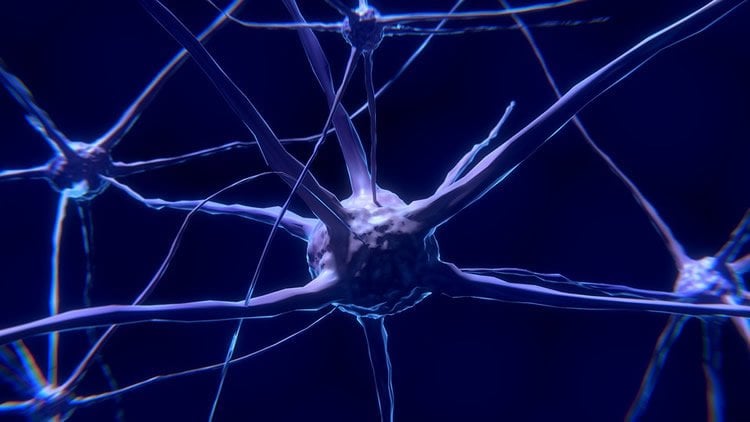Summary: A mouse study reveals nerve cells damaged as a result of diabetes may not be repairable due to low levels of specific cytokines.
Source: Case Western Reserve.
New study out of Case Western Reserve University School of Medicine suggests replenishing cell signaling molecules could improve symptoms.
Molecules that help cells communicate with each other–called cytokines–might be the key to repairing diabetic nerve damage, according to a new study published in Experimental Neurology. Diabetes devastates nerve cells, which can lead to poor circulation, muscle weakness, blindness, and other painful side effects. The new study showed diabetic mice can’t repair nerve cells after damage due to low levels of specific cytokines.
In a mouse model of type 1 diabetes, researchers measured cytokine responses in mice with damaged sciatic nerves. Diabetic mice responded with unusually low levels of cytokines that notify other cells of injury, which in turn hampered activation of reparative genes. The results provide a new explanation for irreparable nerve cell damage seen in diabetic patients.
Replenishing the missing cytokines could help improve symptoms for diabetics, said study lead Richard Zigmond, PhD, professor of neurosciences at Case Western Reserve University School of Medicine, “Our results indicate that targeting this cytokine pathway might alleviate some of the neural complications from diabetes.” Zigmond added that pilot animal studies toward this aim are underway.
Impaired cytokines in diabetic mice included those in the gp130 family–a group of molecules known to trigger extensive networks of cell signals. “Our findings are exciting because they show not only deficits of major gp130 cytokines in diabetic nerve tissue, but they also show changes in their downstream signaling pathways, namely the induction of certain regeneration-associated genes,” Zigmond said. “These results provide a rationale for findings by others that gp130 cytokines can enhance peripheral nerve regeneration in animal models of diabetes.” Until now, researchers weren’t entirely sure why a boost in gp130 cytokines helped improve diabetic symptoms.

Zigmond conducted the study with the help of co-first authors Jon Niemi, PhD and Angela Filous, PhD, both postdoctoral scholars at the medical school. The team is now working to see if the same mechanism of nerve repair is damaged during type 2 diabetes, and which types of nerve cells are involved.
Said Zigmond, “Type 2 diabetes is a major problem worldwide and may or may not involve similar changes in cytokine expression.” By understanding cellular mechanisms common to type 1 and 2 diabetes, the researchers may be able to design broad therapeutics that help reverse nerve cell damage associated with the disease.
Funding: This work was supported by a Pilot Grant from the Juvenile Diabetes Research Fund and a National Institutes of Health grant DK097223 to R.E.Z. J.P.N was supported by training grants NS017512 and NS077888. J.A.L. was supported by F31NS093694. S.D.C. was supported by EY022358.
Source: Marc Kaplan – Case Western Reserve
Image Source: NeuroscienceNews.com image is in the public domain.
Original Research: Abstract for “Injury-induced gp130 cytokine signaling in peripheral ganglia is reduced in diabetes mellitus” by Jon P. Niemi, Angela R. Filous, Alicia DeFrancesco, Jane A. Lindborg, Nisha A. Malhotra, Gina N. Wilson, Bowen Zhou, Samuel D. Crish, and Richard E. Zigmond in Experimental Neurology. Published online June 20 2017 doi:10.1016/j.expneurol.2017.06.020
[cbtabs][cbtab title=”MLA”]Case Western Reserve “Missing Signals Lead to Diabetic Nerve Injury.” NeuroscienceNews. NeuroscienceNews, 1 August 2017.
<diabetic-nerve-injury-7219/>.[/cbtab][cbtab title=”APA”]Case Western Reserve (2017, August 1). Missing Signals Lead to Diabetic Nerve Injury. NeuroscienceNew. Retrieved August 1, 2017 from diabetic-nerve-injury-7219/[/cbtab][cbtab title=”Chicago”]Case Western Reserve “Missing Signals Lead to Diabetic Nerve Injury.” diabetic-nerve-injury-7219/ (accessed August 1, 2017).[/cbtab][/cbtabs]
Abstract
Injury-induced gp130 cytokine signaling in peripheral ganglia is reduced in diabetes mellitus
Neuropathy is a major diabetic complication. While the mechanism of this neuropathy is not well understood, it is believed to result in part from deficient nerve regeneration. Work from our laboratory established that gp130 family of cytokines are induced in animals after axonal injury and are involved in the induction of regeneration-associated genes (RAGs) and in the conditioning lesion response. Here, we examine whether a reduction of cytokine signaling occurs in diabetes. Streptozotocin (STZ) was used to destroy pancreatic β cells, leading to chronic hyperglycemia. Mice were injected with either low doses of STZ (5 × 60 mg/kg) or a single high dose (1 × 200 mg/kg) and examined after three or one month, respectively. Both low and high dose STZ treatment resulted in sustained hyperglycemia and functional deficits associated with the presence of both sensory and autonomic neuropathy. Diabetic mice displayed significantly reduced intraepidermal nerve fiber density and sudomotor function. Furthermore, low and high dose diabetic mice showed significantly reduced tactile touch sensation measured with Von Frey monofilaments. To look at the regenerative and injury-induced responses in diabetic mice, neurons in both superior cervical ganglia (SCG) and the 4th and 5th lumbar dorsal root ganglia (DRG) were unilaterally axotomized. Both high and low dose diabetic mice displayed significantly less axonal regeneration in the sciatic nerve, when measured in vivo, 48 h after crush injury. Significantly reduced induction of two gp130 cytokines, leukemia inhibitory factor and interleukin-6, occurred in diabetic animals in SCG 6 h after injury compared to controls. Injury-induced expression of interleukin-6 was also found to be significantly reduced in the DRG at 6 h after injury in low and high dose diabetic mice. These effects were accompanied by reduced phosphorylation of signal transducer and activator of transcription 3 (STAT3), a downstream effector of the gp130 signaling pathway. We also found decreased induction of several gp130-dependent RAGs, including galanin and vasoactive intestinal peptide. Together, these data suggest a novel mechanism for the decreased response of diabetic sympathetic and sensory neurons to injury.
“Injury-induced gp130 cytokine signaling in peripheral ganglia is reduced in diabetes mellitus” by Jon P. Niemi, Angela R. Filous, Alicia DeFrancesco, Jane A. Lindborg, Nisha A. Malhotra, Gina N. Wilson, Bowen Zhou, Samuel D. Crish, and Richard E. Zigmond in Experimental Neurology. Published online June 20 2017 doi:10.1016/j.expneurol.2017.06.020






